I was following stack question How can I set up a letsencrypt SSL certificate and use it in a Spring Boot application? to configure my Springboot app to use https(certbot) but my Nginx is not redirecting properly to my application.
More context: I am using Cloudflare, to redirect www.example.com (my domain) requests to the machine where I have Nginx and my Springboot app. I want Nginx to redirect this http on port 80 requests to my application that is running on port 8443 (https). I have installed certbot (letsencrypt) certificates and set up my nginx config with those.
My configuration after generating my certificate is below:
Springboot application.properties
server.port=8443
security.require-ssl=true
server.ssl.key-store=/etc/letsencrypt/live/mydomain/keystore.p12
server.ssl.key-store-password=mydomain
server.ssl.keyStoreType=PKCS12
server.ssl.keyAlias=myAlias
Update 1 >> Nginx /etc/nginx/nginx.conf
pid /run/nginx.pid;
events {
worker_connections 768;
}
http {
log_format formatWithUpstreamLogging '[$time_local] $remote_addr - $remote_user - $server_name to: $upstream_addr: $request';
access_log /var/log/nginx/access.log formatWithUpstreamLogging;
error_log /var/log/nginx/error.log;
server {
listen 80;
server_name www.example.com example.com;
return 301 https://$server_name$request_uri;
}
# SSL configuration
server {
listen 443 ssl;
server_name www.example.com example.com;
ssl_certificate /etc/letsencrypt/live/example.com/fullchain.pem;
ssl_certificate_key /etc/letsencrypt/live/example.com/privkey.pem;
location / {
proxy_set_header X-Real-IP $remote_addr;
proxy_set_header X-Forwarded-For $proxy_add_x_forwarded_for;
proxy_set_header Host $host;
proxy_set_header X-NginX-Proxy true;
proxy_pass https://localhost:8443/;
}
}
}
Output of the command nginx -T
nginx: the configuration file /etc/nginx/nginx.conf syntax is ok
nginx: configuration file /etc/nginx/nginx.conf test is successful
# configuration file /etc/nginx/nginx.conf:
pid /run/nginx.pid;
events {
worker_connections 768;
}
http {
log_format formatWithUpstreamLogging '[$time_local] $remote_addr - $remote_user - $server_name to: $upstream_addr: $request';
access_log /var/log/nginx/access.log formatWithUpstreamLogging;
error_log /var/log/nginx/error.log;
server {
listen 80;
server_name www.example.com example.com;
return 301 https://$server_name$request_uri;
}
# SSL configuration
server {
listen 443 ssl;
server_name www.example.com example.com;
ssl_certificate /etc/letsencrypt/live/example.com/fullchain.pem; # managed by Certbot
ssl_certificate_key /etc/letsencrypt/live/example.com/privkey.pem;
# managed by Certbot
location / {
proxy_set_header X-Real-IP $remote_addr;
proxy_set_header X-Forwarded-For $proxy_add_x_forwarded_for;
proxy_set_header Host $host;
proxy_set_header X-NginX-Proxy true;
proxy_pass https://localhost:8443/;
}
}
}
Output of the command nginx -T
nginx: the configuration file /etc/nginx/nginx.conf syntax is ok
nginx: configuration file /etc/nginx/nginx.conf test is successful
# configuration file /etc/nginx/nginx.conf:
pid /run/nginx.pid;
events {
worker_connections 768;
}
http {
log_format formatWithUpstreamLogging '[$time_local] $remote_addr - $remote_user - $server_name to: $upstream_addr: $request';
access_log /var/log/nginx/access.log formatWithUpstreamLogging;
error_log /var/log/nginx/error.log;
server {
listen 80;
server_name www.example.com example.com;
return 301 https://$server_name$request_uri;
}
# SSL configuration
server {
listen 443 ssl;
server_name www.example.com example.com;
ssl_certificate /etc/letsencrypt/live/example.com/fullchain.pem; # managed by Certbot
ssl_certificate_key /etc/letsencrypt/live/example.com/privkey.pem;
# managed by Certbot
location / {
proxy_set_header X-Real-IP $remote_addr;
proxy_set_header X-Forwarded-For $proxy_add_x_forwarded_for;
proxy_set_header Host $host;
proxy_set_header X-NginX-Proxy true;
proxy_pass https://localhost:8443/;
}
}
}
Update 2 >>> Nginx /etc/nginx/nginx.conf
pid /run/nginx.pid;
events {
worker_connections 768;
}
http {
log_format formatWithUpstreamLogging '[$time_local] $remote_addr - $remote_user - $server_name to: $upstream_addr: $request';
access_log /var/log/nginx/access.log formatWithUpstreamLogging;
error_log /var/log/nginx/error.log;
server {
listen 80;
server_name www.codeonblue.com.br codeonblue.com.br;
ssl_certificate /etc/letsencrypt/live/codeonblue.com.br/fullchain.pem; # managed by Certbot
ssl_certificate_key /etc/letsencrypt/live/codeonblue.com.br/privkey.pem;
# managed by Certbot
location / {
proxy_set_header X-Real-IP $remote_addr;
proxy_set_header X-Forwarded-For $proxy_add_x_forwarded_for;
proxy_set_header Host $host;
proxy_set_header X-NginX-Proxy true;
proxy_pass https://localhost:8443/;
}
}
}
When I start nginx and my springboot application and try to access www.example.com in Chrome I get this page (image below)
Here is what I get when I try to access by Firefox:

Since /var/log/nginx/error.log had no entries I have check the access log and there are dozens of requests like this (though I only did one request):
Nginx access log (/var/log/nginx/access.log)
[06/Mar/2019:12:59:52 +0000] <same-IP-address> - - - www.example.com to: -: GET / HTTP/1.1
Here are the curl results:
curl -I https://www.example.com/
HTTP/1.1 301 Moved Permanently
Date: Wed, 06 Mar 2019 14:32:26 GMT
Content-Type: text/html
Connection: keep-alive
Set-Cookie: __cfduid=d330e880850b37d5a9870c1edb71ab8c01551882746; expires=Thu, 05-Mar-20 14:32:26 GMT; path=/; domain=.example.com; HttpOnly
Location: https://www.example.com/
Expect-CT: max-age=604800, report-uri="https://report-uri.cloudflare.com/cdn-cgi/beacon/expect-ct"
Server: cloudflare
CF-RAY: 4b3509fdb8e0c879-MIA
curl -I http://www.example.com/
HTTP/1.1 301 Moved Permanently
Date: Wed, 06 Mar 2019 14:32:56 GMT
Content-Type: text/html
Connection: keep-alive
Set-Cookie: __cfduid=d9e1f2908ee4037d46bffa6866549c3151551882776; expires=Thu, 05-Mar-20 14:32:56 GMT; path=/; domain=.example.com; HttpOnly
Location: https://www.example.com/
Server: cloudflare
CF-RAY: 4b350ab9d83fc895-MIA
Could anyone help me on this issue? What did I miss?
Update 3 >>> More changes in nginx.conf and cleaning cloudflare cache
Nginx /etc/nginx/nginx.conf
pid /run/nginx.pid;
events {
worker_connections 768;
}
http {
log_format formatWithUpstreamLogging '[$time_local] $remote_addr - $remote_user - $server_name to: $upstream_addr: $request';
#main log format
log_format main '$remote_addr - $remote_user [$time_local] "$request" '
'$status $body_bytes_sent "$http_referer" '
'"$http_user_agent" "$http_x_forwarded_for"';
access_log /var/log/nginx/access.log main;
error_log /var/log/nginx/error.log;
server {
listen 80;
server_name www.codeonblue.com.br codeonblue.com.br;
ssl_certificate /etc/letsencrypt/live/codeonblue.com.br/fullchain.pem; # managed by Certbot
ssl_certificate_key /etc/letsencrypt/live/codeonblue.com.br/privkey.pem;
# managed by Certbot
location / {
proxy_set_header X-Real-IP $remote_addr;
proxy_set_header X-Forwarded-For $proxy_add_x_forwarded_for;
proxy_set_header Host $host;
proxy_set_header X-NginX-Proxy true;
proxy_pass https://localhost:8443/;
}
}
}
After this update part of the problem was solved:
Curl test
curl -I http://www.example.com
HTTP/1.1 200
Date: Wed, 06 Mar 2019 22:19:11 GMT
Content-Type: text/html;charset=UTF-8
Connection: keep-alive
Set-Cookie: __cfduid=d3f91ee93c3657a851354dbb4f03741a31551910750; expires=Thu, 05-Mar-20 22:19:10 GMT; path=/; domain=.example.com; HttpOnly
Last-Modified: Wed, 06 Mar 2019 22:03:01 GMT
Accept-Ranges: bytes
Content-Language: en-US
Server: cloudflare
CF-RAY: 4b37b5b08cf05eb2-TPA
In the browsers Firefox / Chrome the front end part is visible as you can see in the picture below:
Firefox
Chrome
New issues:
- The certificate being used is from cloudflare, not from certbot (letsencrypt). Chrome does not consider it good enough and keep showing as "Not secure".
- The endpoint of my application is not been called I don't know why yet. Maybe I am calling the wrong address. How should I call my endpoint?
In the access log I have accessed:
- curl -I www.example.com.br
- Accessed http://www.example.com.br in Firefox
- Accessed http://www.example.com.br in Chrome
- Try to access my endpoint in Postman
Nginx access log (/var/log/nginx/access.log)
172.68.78.24 - - [06/Mar/2019:22:19:11 +0000] "HEAD / HTTP/1.1" 200 0 "-" "curl/7.47.0" "<ip-address-of-my-machine>"
172.68.78.24 - - [06/Mar/2019:22:19:46 +0000] "GET / HTTP/1.1" 200 578 "-" "Mozilla/5.0 (X11; Ubuntu; Linux x86_64; rv:65.0) Gecko/20100101 Firefox/65.0" "<ip-address-of-my-machine>"
172.68.78.36 - - [06/Mar/2019:22:19:46 +0000] "GET /runtime.js HTTP/1.1" 200 6224 "https://www.example.com/" "Mozilla/5.0 (X11; Ubuntu; Linux x86_64; rv:65.0) Gecko/20100101 Firefox/65.0" "<ip-address-of-my-machine>"
172.68.78.42 - - [06/Mar/2019:22:19:46 +0000] "GET /main.js HTTP/1.1" 200 19198 "https://www.example.com/" "Mozilla/5.0 (X11; Ubuntu; Linux x86_64; rv:65.0) Gecko/20100101 Firefox/65.0" "<ip-address-of-my-machine>"
172.68.78.54 - - [06/Mar/2019:22:19:46 +0000] "GET /styles.js HTTP/1.1" 200 185363 "https://www.example.com/" "Mozilla/5.0 (X11; Ubuntu; Linux x86_64; rv:65.0) Gecko/20100101 Firefox/65.0" "<ip-address-of-my-machine>"
172.68.78.96 - - [06/Mar/2019:22:19:46 +0000] "GET /polyfills.js HTTP/1.1" 200 228524 "https://www.example.com/" "Mozilla/5.0 (X11; Ubuntu; Linux x86_64; rv:65.0) Gecko/20100101 Firefox/65.0" "<ip-address-of-my-machine>"
172.68.78.42 - - [06/Mar/2019:22:19:46 +0000] "GET /vendor.js HTTP/1.1" 200 6821593 "https://www.example.com/" "Mozilla/5.0 (X11; Ubuntu; Linux x86_64; rv:65.0) Gecko/20100101 Firefox/65.0" "<ip-address-of-my-machine>"
172.68.78.18 - - [06/Mar/2019:22:19:48 +0000] "GET /favicon.ico HTTP/1.1" 200 5430 "-" "Mozilla/5.0 (X11; Ubuntu; Linux x86_64; rv:65.0) Gecko/20100101 Firefox/65.0" "<ip-address-of-my-machine>"
172.68.78.60 - - [06/Mar/2019:22:20:36 +0000] "GET / HTTP/1.1" 200 578 "-" "Mozilla/5.0 (X11; Linux x86_64) AppleWebKit/537.36 (KHTML, like Gecko) Chrome/72.0.3626.121 Safari/537.36" "<ip-address-of-my-machine>"
172.68.78.60 - - [06/Mar/2019:22:21:33 +0000] "GET / HTTP/1.1" 200 578 "-" "Mozilla/5.0 (X11; Linux x86_64) AppleWebKit/537.36 (KHTML, like Gecko) Chrome/72.0.3626.121 Safari/537.36" "<ip-address-of-my-machine>"
172.68.78.60 - - [06/Mar/2019:22:22:06 +0000] "GET / HTTP/1.1" 304 0 "-" "Mozilla/5.0 (X11; Linux x86_64) AppleWebKit/537.36 (KHTML, like Gecko) Chrome/72.0.3626.121 Safari/537.36" "<ip-address-of-my-machine>"
221.229.166.47 - - [06/Mar/2019:22:32:53 +0000] "GET / HTTP/1.1" 200 578 "-" "Mozilla/4.0 (compatible; MSIE 6.0; Windows NT 5.1" "-"
172.68.78.60 - - [06/Mar/2019:22:44:06 +0000] "GET / HTTP/1.1" 200 578 "-" "PostmanRuntime/7.1.1" "<ip-address-of-my-machine>"
In Postman when I try to access the endpoint like:
https://www.example.com:8443/api/cars
I get a big output where I think this part is more important:
(...)
<title>www.example.com | 522: Connection timed out</title>
(...)
<h2 class="cf-subheadline">Connection timed out</h2>
(...)
<span class="cf-status-desc">www.example.com</span>
(...)
<h2>What happened?</h2>
<p>The initial connection between Cloudflare's network and the origin web server timed out. As a result, the web page can not be displayed.</p>
<h5>If you're the owner of this website:</h5>
<span>Contact your hosting provider letting them know your web server is not completing requests. An Error 522 means that the request was able to connect to your web server, but that the request didn't finish. The most likely cause is that
something on your server is hogging resources.
</span>
(...)
I presume the time out is due to the wrong way I am accessing my service / endpoint. So, how should I access it now? How can I set up nginx to use the certbot certificate instead of cloudflare's ?


